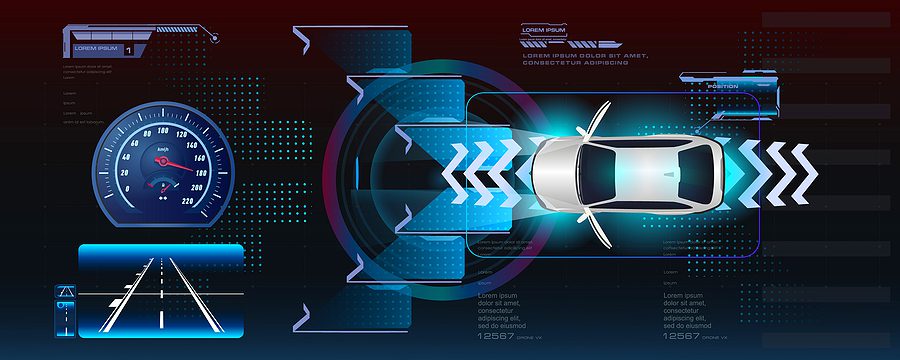
How AI Technology is Implemented in Driver Assisted Devices
When it comes to today’s automotive technology, Artificial Intelligence (AI) plays a pivotal role, particularly in enhancing driver safety and comfort. This technology, embedded in Advanced Driver-Assistance Systems (ADAS), is reshaping how drivers interact with their vehicles, with a goal of ensuring a safer driving experience while still requiring the driver’s active engagement.
Understanding ADAS
Advanced Driver-Assistance Systems (ADAS) refer to a range of electronic technologies that assist drivers in driving and parking functions. Using a variety of sensors such as cameras, radar, and LiDAR, along with sophisticated algorithms, ADAS can detect nearby obstacles or driver errors, and respond accordingly. Here’s an overview of how these systems work:
- Sensors and Cameras: Serving as the critical eyes of the ADAS, sensors and cameras continuously scan the vehicle’s surroundings. These devices collect data in real-time, capturing everything from nearby vehicles and pedestrian movements to lane markings and road conditions. This comprehensive sensory input is essential for the system to assess and react to dynamic driving environments accurately.
- Processing Unit: Functioning as the brain of the ADAS, the processing unit receives raw data from sensors and cameras and interprets it with sophisticated algorithms. This unit identifies potential hazards, recognizes traffic signs, and determines the car’s position relative to road boundaries. By processing this information, the unit makes informed decisions to aid in safe driving.
- Actuators: Actuators are the mechanical hands of the ADAS, responsible for executing the system’s commands. When the processing unit detects a need for intervention, actuators take action—whether it’s adjusting the steering wheel to maintain lane integrity, activating brakes to prevent a collision, or issuing auditory and visual alerts to the driver. These responsive actions are intended to instantly react to help prevent accidents and enhance driver safety.
Over the past few decades, ADAS have become integral parts of modern vehicles. Initially composed of basic functions like anti-lock braking systems (ABS) and cruise control, ADAS has since evolved to encompass more sophisticated features. These include Automatic Emergency Braking, which detects imminent collisions and applies brakes automatically to prevent or mitigate accidents. Lane Keeping Assist actively monitors lane markings and adjusts the steering to keep the vehicle centered within its lane. Adaptive Cruise Control adjusts vehicle speed to maintain a safe distance from the car ahead, enhancing comfort and alleviating fatigue during long drives. Traffic Sign Recognition utilizes cameras to identify road signs, offering alerts or adjustments to ensure compliance with traffic regulations. Blind Spot Detection monitors bring awareness to areas not easily visible to the driver, alerting them to other vehicles in adjacent lanes to prevent side collisions.
The Role of the Driver
Despite the sophistication of ADAS, the importance of a vigilant and attentive driver cannot be overstated. These systems are designed to assist, not replace, human drivers. Effective use of ADAS requires drivers to remain focused on the road and maintain control over the vehicle at all times. The technology serves to enhance safety but is not infallible; environmental conditions, sensor limitations, and unexpected scenarios can still pose challenges that require human intervention.

Pros and Cons of ADAS
The integration of AI in driver-assisted devices offers numerous benefits but also presents some drawbacks. Here are some key points:
Advantages:
- Increased Safety: Advanced Driver-Assistance Systems significantly reduce the risk of accidents by employing a combination of alerts and active interventions. Features like Automatic Emergency Braking and Blind Spot Detection act in critical moments to prevent collisions, ensuring both driver and passenger safety through this proactive technology.
- Enhanced Comfort: Features like Adaptive Cruise Control and Lane Keeping Assist reduce the physical and mental demands of driving, particularly on long journeys. These technologies help maintain safe distances between vehicles and ensure consistent lane positioning, providing a more relaxed and comfortable driving experience.
- Better Traffic Management: By optimizing driving patterns and reducing the frequency of sudden stops and starts, ADAS contributes to smoother traffic flow. Technologies like Adaptive Cruise Control adjust to the pace of surrounding traffic, helping to minimize congestion and improve overall road efficiency. This not only enhances individual commutes but also benefits the broader traffic system.
Disadvantages:
- Reliability Issues: While ADAS technologies offer substantial safety benefits, they are not immune to reliability issues. Sensor malfunctions, such as those caused by adverse weather conditions or system errors, can lead to incorrect readings or failures. These situations can potentially result in dangerous driving scenarios if the system fails to perform as expected, emphasizing the need for regular maintenance and system updates.
- Over-reliance: There is an inherent risk that drivers might become overly dependent on driver assistance technologies. This reliance can lead to a decrease in driver alertness and situational awareness. As drivers trust these systems to handle more aspects of driving, their own skills and attentiveness may diminish, which can be hazardous if the technology fails or in situations where manual intervention is crucial.
- Cost: Implementing advanced driver-assistance systems in vehicles can increase both the initial purchase price and the ongoing maintenance and subscription costs. These technologies require sophisticated sensors and computing hardware that are expensive to develop, install, and maintain. The costs vary from manufacturer to manufacturer and feature to feature. Depending on what is opted for, these safety features will likely be less accessible to the average consumer, potentially limiting their widespread adoption.
Keeping Safety in the Driver’s Seat
While ADAS technologies offer impressive benefits, they require drivers to understand their functionalities and limitations. Continuous education on how to effectively use these systems, coupled with the need for regular maintenance and updates, ensures they continue to function as expected.
For anyone considering upgrading their vehicle with driver-assisted technologies, or simply looking to better understand how these systems can benefit their driving experience, getting professional advice is helpful. To learn more about how you can keep yourself and others safer on the roadways, check out our Law Blog for tips and information. Contact us right away at (419) 782-9881 for a free consultation to discuss your legal options.